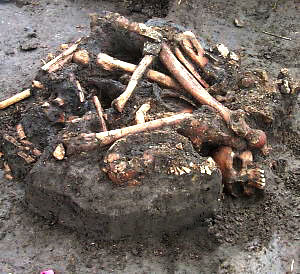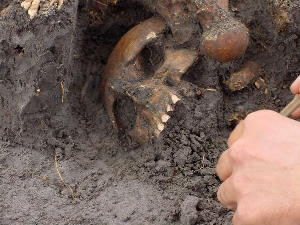It appears fairly certain that these three skeletons were those discovered—and subsequently buried—by members of the De Leon expedition in April 1689 while conducting reconnaissance at the ruined French settlement. The Spanish account describes finding three badly decomposed bodies—a woman and two men—lying in a field near the chapel ruins. The French settlement had been burned by the Karankawa during the December 1688 massacre. Apparently, the bodies had lain on the ground since that time, exposed to the elements and scavenged by wild animals and necrophageous (flesh-eating) insects.
King found the skeletons to be in poor condition, showing signs of weathering; numerous bones were missing. Nonetheless, there were sufficient elements present to account for three individuals.
One skeleton was that of a white female, 25-25 years in age; a second was a male, 30-45 years old, and the third a boy, somewhere between 7 and 10 years old. The female had suffered a massive blow to the skull. The adult male had two blunt force injuries on his skull as well as a perforating injury. A study of the teeth of the adults showed changes in the enamel caused by either periodic bouts of malnutrition or infections that sapped protein from the body. There also were indications the adult male had suffered from syphilis.
The juvenile was represented by only a few bones and four deciduous (primary, or baby) teeth, the latter recovered from backfill.
In his report, King concludes with a poignant tribute to the people represented in the burials:
These few observations of three individuals, now reduced to almost elemental status, cannot begin to comprehend the lives they represent: Two of adult age whose decisions led them to their ultimate ends in the New World, and a third in his nonage in the care of others whose short life was lived out in a strange place. How much fuller and richer were their lives than these few remarks on their physical remains. These observations are dedicated to them and to their spirit of adventure and new beginnings in a ‘brave new world’.
|

Remains of what are believed to be three French settlers, shown following excavation. Photo courtesy of Texas Historical Commission.  |

| We found three dead bodies scattered over the plain. One of these, from the dress that still clung to the bones, appeared to be that of a woman. We took the bodies up, chanted mass with the bodies present, and buried them. We looked for the other dead bodies but could not find them; whence we supposed that they had been thrown into the creek and had been eaten by alligators, of which were many.
-General Alonso de León, April 22, 1689
|

Closeup of a skull, shown as it is being carefully cleaned during excavations. Photo courtesy of Texas Historical Commission.  |
|